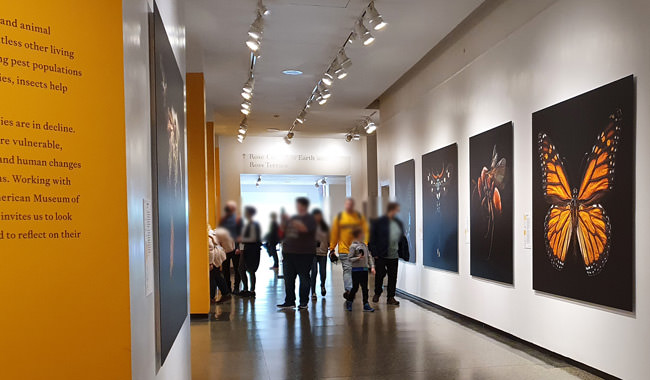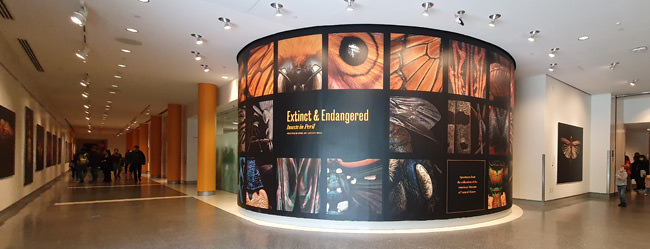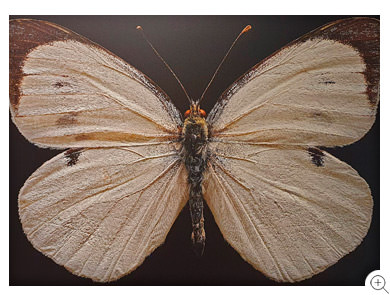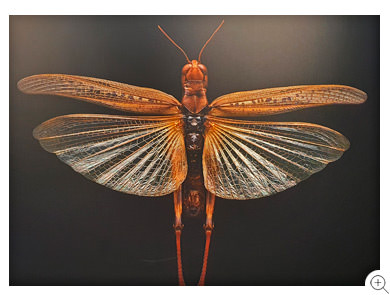The American Museum of Natural History in New York has been holding a thrilling yet terrifying exhibition of large-format insect photography, entitled Extinct & Endangered. Their entomological curators selected 80 specimens of dead insects held in their collection, classing them-eponymously - as recently extinct or endangered. These specimens were sent across the Atlantic to Levon Bliss, a British photographer, who went to work to create a series of eye-catching photographs. Forty of these images are on display, some as large as 4.5 feet by 8 feet in size, some having been combined from as many as 10,000 separate images. Macrophotography comes alive on these walls, in pursuit of a terrible story.
This is the text the museum uses at the start of the display:
Pay attention to insects.
Many pollinate plants. Some recycle plant and animal matter into the soil. They are food for countless other living things-and even for one another, often keeping pest populations in check. Whether beetles, bees or butterflies, insects help natural ecosystems stay healthy.
But the evidence is clear: many insect species are in decline. The ones featured in these photographs are vulnerable, imperiled - or have already disappeared - and human changes to the land and climate are primary reasons. Working with specimens from the collections of the American Museum of Natural History, photographer Levon Bliss invites us to look closely at the beauty of these insects - and to reflect on their importance to the planet we share.

The two websites to visit are Extinct & Endangered and Levon Biss. What you can see below are my own low-res camera phone snaps, post-processed to remove some of the glare created by overhead lighting. With luck, they hint at the detail visible on the museum’s walls.
Coral Pink Sand Dunes Tiger Beetle
- Utah, USA
- critically endangered
- susceptible to climate change and off-road SUV use
Esperanza Swallowtail
- Oaxaca, Mexico
- endangered
- climate change, habitat fragmentation and logging
Louisiana Eyed Silkmoth
- Louisiana, USA
- imperiled
- habitat disappearance, erosion, climate change and oil spills
San Joaquin Valley Flower-loving Fly
- California, USA
- critically imperiled
- sand mining, agriculture and climate change
Monarch Butterfly
- north-east USA
- endangered/threatened
- herbicides, insecticides and illegal logging
Monarch Butterfly - detail
- north-east USA
- endangered/threatened
- herbicides, insecticides and illegal logging
Some shots of the display corridors give a good impression of the size of these images:


Microsculpture: the insect portraits of Levon Bliss has been especially developed to present these images with magnification capabilities that will match what’s on the walls of the American Museum of Natural History. It’s well worth a visit.
The degree of detail provided in the museum alongside each of these images is crisp and digestible. Below is the label accompanying the Rasp Silk Moth from Mexico. The story told is cumulatively horrifying.

I have written before of the peril facing the insects that live alongside us - and eventually the peril we face as a consequence. Michael McCarthy’s Moth Snowstorm: Nature and Joy, Dave Goulson’s Silent Earth: Averting the Insect Apocalypse and Oliver Milman’s The Insect Crisis: The Fall of the Tiny Empires that Run the World all tread the same path. The sixth mass extinction is upon us and insects are no more exempt than any other class of creature.
I was therefore interested to see what other displays the Museum had on insects. We were directed to the 11,000 square-foot Hall of Biodiversity, a mind-boggling space celebrating life’s biodiversity and beauty. One section devoted to insects ran from floor to ceiling:

In pride of place as a single organising thought for the whole display was a small panel prominently quoting the words of the great American biologist E.O. Wilson:

It was eerie encountering these words practically adjacent to such a display of exquisite photographs in the same museum. They are ones that I have quoted in conversation countless times, and cited in two of the reviews mentioned above. Here they are again … because we ignore them at our peril:
So important are insects and other land-dwelling arthropods that if all were to disappear, humanity probably could not last more than a few months. (Edward O. Wilson, The Diversity of Life, p. 125)
To the general public, unless stung or bitten by one, insects are almost too small to notice. They are traditionally nuisance rather than friend. Reversing that understanding takes something of a leap of imagination. If the photographs of Levon Biss can help in that, showing the intrinsic beauty that so many of them have when viewed close-up, then this exhibition and others like it will have been worth it.
Links
- Extinct & Endangered
- The website of Levon Biss
- A nice article about a 2017 exhibition of similar photographs displayed at the Oxford University Museum of Natural History, which also contains a video portrait of the photographer and the techniques he uses to achieve these remarkable results.
- A 2017 TED talk by Levon Biss
- Microsculpture: the insect portraits of Levon Bliss















